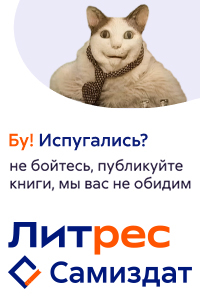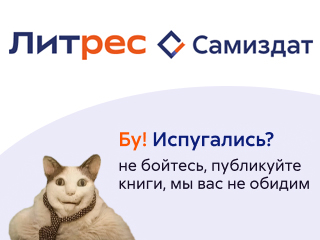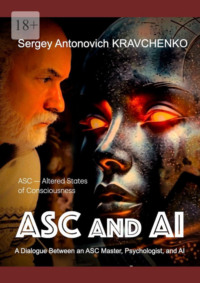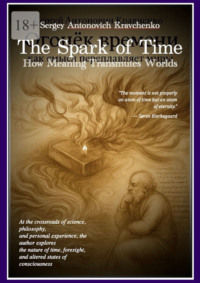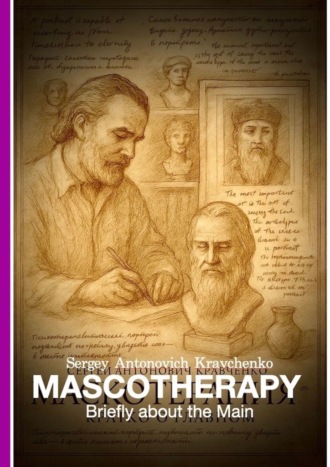
Полная версия
Mascotherapy: Briefly about the Main
Mascotherapy helps us explore these masks and the subpersonalities behind them. It allows us to build inner dialogues – consciously or not – between the masks we wear. Ideally, the individual learns to speak with them openly, to understand them, to integrate them into their sense of self.
In the most severe cases – as G. M. Nazloyan wrote – the patient’s inner dialogue may be completely absent at first. This is the core of their suffering: pathological aloneness. But when the first response appears – in a portrait, in a mirror, in another’s gaze – then the internal dialogue begins to stir. And from within the subpersonalities, the first inner conversation begins to take shape.
The concept of the mask in mascotherapy is not an abstract metaphor. It is a concrete, observable reality. The masks in portraits are not always benevolent. Sometimes they evoke heavy emotions. But once they appear, they become objects of external observation. And thus – they can be engaged with, spoken to, and transformed.
If a method works with masks – how else could it be named?
The Essence of Contemporary Mascotherapy
This chapter forms the methodological core of the book. The author articulates mascotherapy as a unique integrative method that combines the artistic practice of portrait creation with deep psychological work involving the multilayered structure of the personality. Through the process of creating self-portraits, different strata of the psyche are revealed – from instinctual and ancestral layers to personal and leadership levels. Mascotherapy is presented not merely as a therapeutic modality but as a path to inner transformation, self-knowledge, and even a touch of eternity. Special emphasis is placed on the aesthetic mediator – the portrait – as both a tool of transformation and a vessel of the immortal image. This chapter outlines the boundaries between mascotherapy and other methods, arguing convincingly for its uniqueness.
Mascotherapy is a developmental, diagnostic, psychotherapeutic, and consultative practice in which the central element is the creation of a sculptural or graphic portrait. Additional forms may include theatrical makeup, photographic portraiture, or video recordings of the client’s dialogue with the therapist – and with their own portrait.
The method facilitates the unveiling of a person’s true self-image, helping to uncover, complement, and evolve layers of personality previously hidden from awareness or distorted. These layers include:
– the instinctual foundation with its drives and needs,
– the anthropic (universal human) layer and connection to nature,
– the ethno-genealogical stratum and ancestral memory,
– the social (familial) level,
– individual traits,
– the personal level,
– the leadership potential.
Focusing on each of these levels through portrait work helps to unlock psychological energies that were previously repressed or inaccessible. This leads to an increase in psychic energy, the awakening of hidden capacities, improved adaptability, harmonization of inner life, and, in many cases, the alleviation of psychological distress.
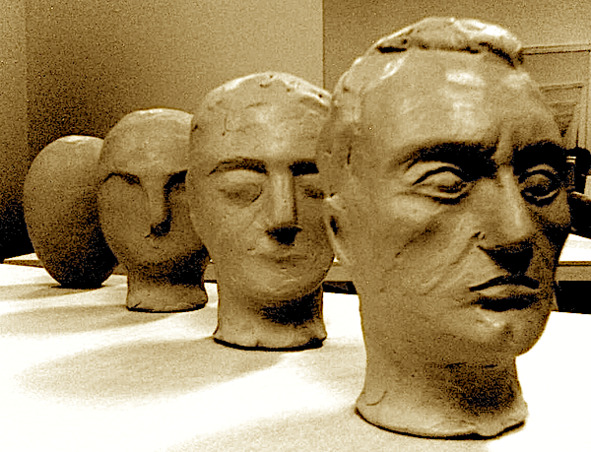
The Initial Stages of Portrait Work
The Initial Stages of Portrait Work
Mascotherapy sessions vary in nature, duration, and frequency. They can last from a few minutes to several hours. The portrait or self-portrait development process often proceeds alongside diagnostic or therapeutic conversations, but long periods of silent client work are also possible. A portrait may evolve over several sessions – or span months or even years.
The number of sessions ranges from 5—10 to 20 or more, depending on the client’s task and internal resources. In most cases, it is the client who determines their readiness to meet the portrait – and thus themselves.
Mascotherapy is rooted in the tradition of portrait art – sculptural, painterly, and graphic. From the earliest times, artists have recognized the power of the portrait: it gave the image durability, outlived its creator, and preserved memory. The aura of immortality has always surrounded portraiture, making it a natural mediator in the processes of psychological guidance and healing.
The essence and power of the method lie in the portrait’s ability to lead the client into inner states where the experience of eternity becomes accessible – a transformative encounter that changes the personality. This kind of experience allows the individual to connect with the dimensions of time – past, present, and future – overcoming timelessness, inner void, depression, and identity crises.
More on this topic can be found in S. A. Kravchenko’s book “Temporal Psychology”, which explores the relationship between psychological processes and temporal dimensions.
More Than Psychotherapy
It is important to understand that mascotherapy is not always psychotherapy in the narrow sense. It can also serve as a developmental or corrective methodology, acting as a central axis around which other approaches in psychology, education, or therapy may revolve. It can be used for:
– self-exploration,
– diagnosis,
– personal development and correction,
– revealing abilities and talents,
– life-path discovery,
– finding one’s unique Face.
The method is particularly indicated in cases where body-image connection is impaired, identity perception is distorted, or contact with reality is diminished. Mascotherapy makes it possible to reach the individual level (the fifth layer) and, at times, go beyond it.
For deeper work, the method “The Face of the Personality” is used – a development that has grown out of mascotherapy. It allows the exploration of personal and leadership levels of the psyche – including their potential pathologies. This will be explored in detail in the forthcoming book “The Face of the Personality.”
From Drama to Dialogue
It is within the sculptural portrait that the “inner dramas” of the masks are most vividly enacted. Here, conflicts are revealed, and dialogues between subpersonalities emerge. This becomes a path toward inner harmony and the affirmation of the Self.
Simply removing a papier-mâché mask is not enough. Humans possess more masks than social roles, and most of these are internal. More on this topic can be found in the book “Masks, Faces, Images,” which explores the functions and typology of masks.
On going beyond masks and roles, see the book “Notes of a Hermit,” where the path to the liberated state of the pure Self is revealed.
The Innate Ability to Sculpt
This chapter reveals a key principle of the method: every person is a creator. Even those who consider themselves “not artists” possess an innate ability to sculpt, along with a natural drive for self-expression. Here, mascotherapy transcends aesthetics and becomes a means of overcoming internal barriers – shame, fear of failure, and creative paralysis. The collaborative process with the therapist, the “exchange of portraits,” symbolizes an act of co-creation and support through which a person can restore lost contact with themselves and their creative origins.
Almost every first encounter with sculptural mascotherapy begins with the same question:
“What if I don’t know how to sculpt?”
Interestingly, such questions are most often asked by adults. Children, by contrast, take clay in hand without hesitation and immediately begin to create. And – it works. It turns out that everyone can sculpt. Even those who haven’t touched clay in decades. The difference lies not in ability, but in one’s attitude toward the process.
Pragmatic, goal-oriented individuals with no artistic background often manage the task more quickly than others. Their self-portrait may be far from technically refined, yet it contains honesty, raw strength, and a unique, recognizable face. Such portraits often make a strong impression – precisely because of their sincerity and vivid presence.
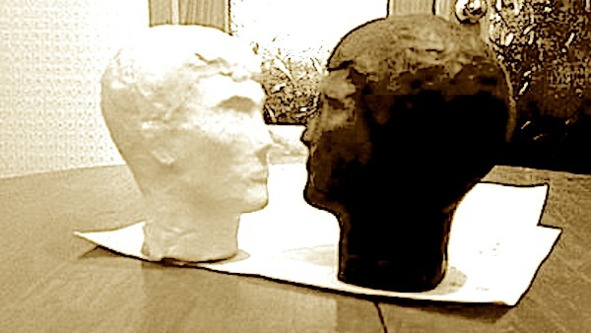
Two portraits of one patient
Things are different with clients who approach the task with hesitation. For them, clay seems threatening: they fear ruining it, doing something “wrong,” receiving poor judgment. Old school-era fears are carried into the creative space – and instead of a living expression of the soul, anxiety emerges.
In such cases, synchronized sculpting proves helpful. If the mascotherapist works alongside the client, sculpting an identical portrait, they can offer their version at the right moment – suggesting more accurate form or direction. After a while, the therapist takes the figure back and refines it. As a result, both work with two sculptures, passing them back and forth. A process of co-creation emerges – where it no longer matters who made what, but rather that together, something greater is achieved.
To avoid confusion, it helps to use different colors of clay: for instance, the main portrait in a flesh tone, and the auxiliary one in olive or dark hues.
Thus, step by step, the client gradually and unconsciously enters the state of a creator. Their hands begin to remember. Their soul – awakens. And, as practice shows, by the end of the session, the person not only has their first self-portrait, but also their first victory over self-doubt.
Methodology within Clinical Practice
This chapter presents mascotherapy as a clinical method centered not on the symptom, but on the person – one experiencing internal conflict, a loss of self-identity, and existential loneliness. In working with portraiture, the individual not only “recreates” their face but also re-establishes contact with the body, ancestral memory, gender, and personal identity. The stages of therapeutic portrait-making are described as a form of deep initiation. The method lies at the intersection of Jungian analytical psychology, temporal psychology, and symbolic art.
What distinguishes mascotherapy as a complex of psychotherapeutic and developmental techniques is its fundamental view of the client – not as a bearer of symptoms, but as a whole personality who has temporarily lost connection with themselves and the world. The focus lies on internal conflicts, distortions of self-identification, and the phenomenon of pathological loneliness, which, according to G. M. Nazloyan, is a universal symptom of most mental disorders.
Modern culture increasingly contributes to depersonalization, the loss of subjectivity, and the substitution of the “Self” with roles, masks, and clichés. This leads to a breakdown of inner dialogue and a rise in psycho-emotional and existential problems. The phenomenon of “losing one’s face” becomes not just a metaphor, but a central element in the disruption of self-perception and the distortion of relationships – with oneself, with others, and with reality as a whole.
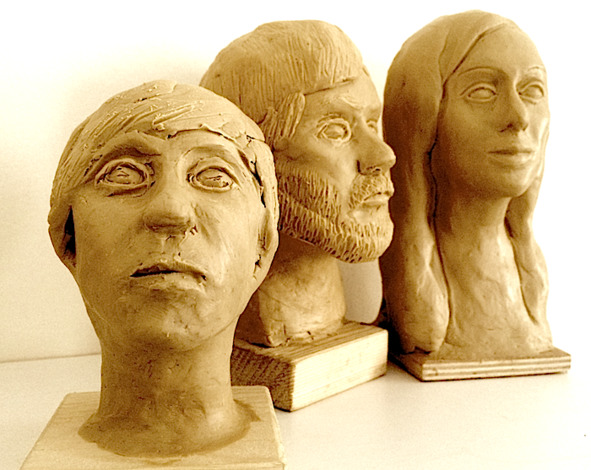
Self-portraits at the stage of genus characteristics
Mascotherapy enables one to “restore the face” – that is, to reestablish coherence between the bodily image and personal consciousness. It is a path to reconstructing the lost “Self,” a method of reviving dialogue – first internal, then external. The therapeutic effect is achieved through symbolic self-creation. A sculptural portrait plays a crucial role here: unlike painted or drawn portraits, it has volume and corporeality, which facilitates identification with the image and deepens the therapeutic process.
One of the method’s unique features is the presence of three participants in the therapeutic process: the client, the psychotherapist, and the portrait. This triad creates a distinct therapeutic space, where the therapist’s role is not to impose interpretations, but to gently accompany and guide the process of self-discovery.
S. A. Kravchenko, a student and follower of G. M. Nazloyan, adapted and expanded the method by integrating it with Carl Jung’s analytical psychology and the theory of temporal psychology. The therapeutic work follows sequential stages corresponding to “layers of the psyche,” each associated with a specific level of personal development and self-understanding:
Stages of Therapeutic Portraiture
– Animal Level – the shape of an egg. Reflects perinatal and postnatal experiences, birth trauma. Often, the client cannot even sculpt this basic form.
– Task: Restoring basic trust in the world.
– Anthropic Level – coarse features resembling archaic sculpture.
– Task: Awareness of one’s relationship to the human community.
– Ancestral Level – a face showing signs of gender and family lineage. Difficulty in defining gender often emerges here, signaling psychosexual disturbances.
– Task: Restoring gender, familial, and ancestral identity.
– Family Level – facial traits begin to reflect those of relatives (grandparents, etc.).
– Task: Working with ancestral memory; overcoming unconscious identification with traumatic family fates.
– Individual Level – emergence of a distinct, recognizable face.
– Task: Forming an integrated “Self” and its temporal coherence (past, present, future, timelessness, eternity). This is the level of catharsis, meaning-making, and the overcoming of temporal neurosis.
– Personal Level (optional) – the stage of self-determination and depth.
– Task: Developing worldview and a mature personality.
– Leadership Level (optional) – awareness of one’s unique mission and responsibility to the world.
– Task: Awakening of spiritual leadership.
The process begins with something small – a sculpture in the shape of an egg.
With each stage, new layers are added, yet the previous ones are not destroyed – they remain within, as symbols of memory and experience. Ideally, the final form approaches the actual size of the patient’s face.
During the creation of the portrait, symbolic and associative processes are activated. For example, a woman may see in the portrait features of her father or a beloved man. In another case, a patient realizes that he is living out someone else’s life script – his grandfather, who struggled with alcoholism, unconsciously became a behavioral model. This insight gives rise to an inner cleansing and a search for one’s own path.
As the resemblance increases, a sense of a “double” emerges. An emotional connection is established with the image, and an inner dialogue comes to life. This leads to catharsis – emotional release and a deepened understanding of oneself and one’s issues.
The psychotherapist’s task is to create the conditions in which the patient can become emotionally attached to their own face. This is a sign that therapy has reached its conclusion. In some cases, the patient is invited to leave their portrait at the clinic – as a symbolic act of parting with illness. Later, the practice of returning the portrait to the client was introduced, allowing them to continue the work at home or remotely.
Mascotherapeutic Techniques Include:
– Verbal portrait;
– Face painting (make-up);
– Photographic portrait;
– Graphic or painted portrait;
– Sculpture from a live model (sculptural portrait).
The method is used in clinical institutions (such as Rehab Family) for the treatment of depression, neuroses, and addictions. Noticeable improvements in emotional well-being and a reduced need for medication are often observed after just 3—4 sessions.
Group formats significantly enhance the therapeutic effect. Clients help each other in the creation of portraits, share observations, and strengthen the process of objectification and acceptance. Family members can participate in the process – comparing likenesses, affirming the importance of what is happening. All of this helps the patient to “regain their face” – not metaphorically, but quite literally.
Thus, mascotherapy becomes not only a method of diagnosis and correction, but a profound process of initiation. To regain one’s face is to return to oneself, to one’s true nature, and to the capacity to live not by someone else’s example, but as a person capable of being truly oneself.
Field of Meaning
This chapter explores the philosophy of the face as a mirror of the soul and the central image in mascotherapy. The mirrored double, the portrait, and the inner dialogue form a field of self-knowledge. The chapter discusses archetypes, masks, layers of the psyche, and the theme of identity. The author touches on the phenomena of catharsis, eternity, the image of the therapist, and the role of perfection. It concludes with a reflection on the connection between a person’s inner and outer appearance, revealed through portrait work.
Face and Mirror
At the core of mascotherapy’s conceptual field lies the face. Through its reflection in the mirror, a person enters into contact with the image of the self. The personality and the soul partially manifest in the face’s expression in the here and now. In observing our mirrored double, we are, to some extent, observing ourselves.
Dialogue with the Double
The dialogue that arises between the personality and its mirrored reflection may become an even more accurate tool for reflecting the soul. Thus, the central element of mascotherapy becomes the face reflected in the mirror – the one hiding the personality – and the dialogue with it. But how accurately do we perceive our own reflection? That cannot be fully known until we attempt to create a portrait.
The Portrait and Observers
By creating a self-portrait while observing their own face in a mirror, a person has the chance to show others what they themselves see. This raises a vital question: how accurately do we convey in a portrait what we perceive? The interaction of observers around the portrait forms the initial dialogue – the criterion of image authenticity.
Masks
In the first stages, masks emerge – stable social roles and archetypes that have surrounded us since childhood. These masks are not accidental; they are part of our psychic and social nature. We should not fear them, but it is crucial to be aware of their presence.
The True Double
The mirrored double is an illusion – but a necessary one. It allows us to see ourselves from the outside, though it reverses left and right. After a few weeks of sculpting, if the work progresses properly, the portrait ceases to be a mirror image – the brain replaces the distorted reflection with an internally recognized form. This marks the shift from external observation to internal vision.
Self-Image
What often prevents the creation of a true portrait is the entrenched image of oneself – a construct made from others’ opinions, past experiences, and social roles. This internal image must be overcome in the search for the authentic face. Masks and self-image intersect, but they are not the same. A mask exists in relation to others, whereas self-image persists even in solitude.
Layers of the Psyche
The true face does not emerge immediately – it lies hidden beneath seven layers of the psyche:
– The animal level (egg-like form),
– The universal human level (emergence of a human image),
– The ancestral level (gender, ethnicity),
– The family level (features of close relatives),
– The individual level (distinct personal traits),
– The personal level (existential meaning),
– The leadership level (the image of a guide who transcends time).
Cloning Faces
While sculpting a patient’s portrait, a therapist may unintentionally imprint their own features onto the image. This is a subtle but important point. To avoid such “cloning,” it is essential to leave the patient alone with the image. Only in solitude can the true face emerge.
Eros and Thanatos
The archetype of Eros – creation – is active during sculpting, but Thanatos – death – is never far. Sculpture is associated with memory, the overcoming of time, and a quest for immortality. A timeless portrait becomes a symbol of the soul’s eternity.
On Eternity and Timelessness
Patients often perceive their portrait as a future or improved version of the self. The portrait captures not only the past, but also the future – it opens temporal dimensions. In the state of timelessness experienced by many patients, creating a portrait becomes an act of creation and a means of returning to the flow of time.
Catharsis
At the conclusion of portrait work, an emotional explosion – a catharsis – occurs. A new face emerges, triggering a cleansing of the soul in the Aristotelian sense. This experience cannot be ignored: the birth of a new self never goes unnoticed.
Status
Sculpted portraits have traditionally been associated with high social status. Because of this, some patients may initially feel unworthy. However, the very process of creating a portrait helps to overcome this belief and affirm one’s self-worth.
Perfection
The portrait’s form must be as precise and perfect as possible. This teaches the person to strive for a kind of perfection – not narcissistic, but soulful and spiritual. A perfected portrait allows one to move beyond masks and draw closer to essence.
Associated Images
During portrait work, images of other people often emerge – significant figures, archetypes, shadows. These must be noted and reflected upon. They are active elements of the psyche and influence both the process and the patient’s life.
Inner and Outer
As the portrait develops, life itself changes. Relationships improve, attentiveness to others’ faces increases, self-understanding deepens. The portrait becomes a metaphor for the journey – from the outer to the inner, from chaos to wholeness, from image to Face.
Faces, Visages, and Images of Civilizations
This chapter reveals the archetypal and cultural-historical role of the human face as a mirror of civilizations. Through sculpted self-portraiture, a person approaches a holistic perception of themselves, their time, and their deep inner nature. Mascotherapy is presented as a means of restoring the lost dialogue between the individual and culture.
The more realistically a person is able to portray their own face, the more refined becomes their perception of the world, others, and themselves.
This idea lies at the heart of mascotherapy – the art of restoring the lost Face, both physical and spiritual. It goes beyond personal therapy and addresses a fundamental question: how capable is civilization, as a whole, of seeing itself?
Paradoxically, humanity – having created countless images of masks, idols, gods, heroes, and monsters – long avoided the most essential subject: the sculpted self-portrait. This genre only emerged with the development of mascotherapy in the 1980s. Until then, the human face in art was always interpreted by someone else: the artist, the sculptor, the state, the ideology – but never by the subject themselves.
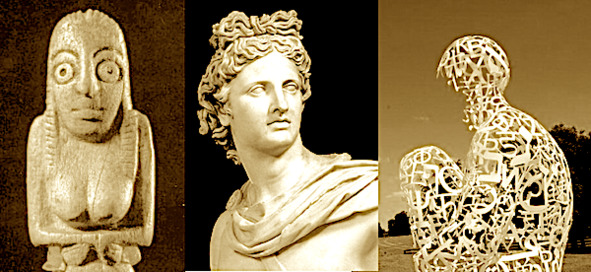
Images of man from prehistoric times to the present day
“Know thyself” – this Delphic maxim was not truly realized in the culture of portraiture until a person took clay in their own hands and began to shape their own likeness.
Across millennia – from the Paleolithic to Postmodernism – the masks and faces of civilizations, from the simplest clay heads to monumental imperial busts, have served as mirrors of their eras.
